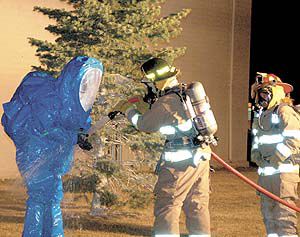| East Carbon city firefighters decontaminate HAZMAT member Zac Palacios. Palacios and Price city Fire Chief Paul Bedont put on full body apparatus in order to investigate an unidentified powder that was brought to East Carbon’s City Hall by a local resident. The substance was discovered by the local man as he opened his mail. According to Bedont there was not enough of the substance left at the scene to conduct a test in the field. |
On the evening of Feb. 16, Carbon County’s hazardous material team responded to the East Carbon City Hall to investigate a report of an unidentified powder brought to the building by a concerned citizen.
According to Police Chief Sam Leonard, East Carbon resident Bob Wells came into the local law enforcement department at approximately 5 p.m. with an envelope sealed in two plastic bags.
Wells reported that when he was opening the letter a white power popped into his face.
Leonard reported that the letter was a solicitation asking for donations toward the provision of medical supplies for third world countries.
Because of recent terroristic events and not knowing what the substance was, Wells became concerned about his health.
Upon receiving the letter Leonard contacted state and local health departments as well as the Federal Bureau of Investigation.
“It was the local Southeastern Utah Health Department that was the biggest immediate help to us,” said the East Carbon police chief. “They are the ones who got the ball rolling.
At approximately 5:45 p.m. last Friday, the county HAZMAT team, Sunnyside Emergency Medical Services and the East Carbon Fire Department converged on the scene.
HAZMAT personnel controlled the scene by establishing danger and safe zones, parking upwind and utilizing a management system.
The emergency management system included using unmanned vehicles as barricades to isolate the area
HAZMAT team members Zac Palacios and Paul Bedont put on full body, self-contained protective apparatus in order to inspect the material.
One of the first things the team wanted to do was rule out the possibility of anthrax.
According to the United States Centers for Disease Control and Prevention, the acute and infectious disease is caused by the spore-forming bacillus anthracis.
Because of terrorism concerns, anthrax is primarily thought of as weapons grade agent.
But the bacterium is most common in agricultural regions where anthrax occurs in animals.
When anthrax occurs in humans, the infection is usually due to an occupational exposure to infected animals or animal products.
The disease may also occur in workers who are exposed to dead animals and animal products from other counties where anthrax is more common.
Symptoms of the disease vary depending on how anthrax was contracted. But the symptoms usually occur within three days.
Anthrax infection can occur in three forms: cutaneous, inhalation and gastrointestinal.
In the cutaneous form, 95 percent of anthrax infections occur when the bacterium enters a cut or abrasion on the skin.
Skin infection begins as a raised itchy bump that resembles an insect bite but within one to two days develops into a vesicle and then a painless ulcer with a characteristic black necrotic area in the center.
About 20 percent of untreated cases will result in death.
In the inhalation form, the initial symptoms may resemble a common cold.
After several days, the symptoms may progress to severe breathing problems and shock.
Inhalation anthrax is usually fatal.
| Local EMTs Kami Christiansen and Gail Raby check HAZMAT team members Zac Palacios and Paul Bedont after they inspected an unidentified substance. |
The intestinal disease form of anthrax may follow the consumption of contaminated meat and is characterized by an acute inflammation of the intestinal tract.
Initial signs of nausea, loss of appetite and fever are followed by abdominal pain, vomiting of blood and severe diarrhea.
Intestinal anthrax results in death in 25 percent to 60 percent of cases.
The disease is diagnosed by isolating B anthracis from the blood, skin lesions or respiratory secretions or by measuring specific antibodies in the blood of persons with suspected cases.
Medical doctors frequently prescribe antibiotics to treat the infections.
To be effective treatment should be initiated early. If left untreated the disease is usually fatal.
According to Price fire chief and HAZMAT member Paul Bedont, the team was unable to locate or recover enough powder from the envelope to adequately field test the unknown substance.
Bedont reported that Wells didn’t demonstrate any symptoms, usually respiratory distress that comes along with acute exposure to weapons grade anthrax.
However, the HAZMAT team responded as if dealing with an anthrax exposure incident.
When dealing with an unknown substance, the team tries to assume the worst possible scenario, said Bedont.
“It’s sad that we live in a society where good people such as Wells have to be concerned about possible terrorist incidents,” concluded the Price fire chief.
After arriving at the scene, the HAZMAT members, in conjunction with Sunnyside ambulance personnel, established a sector to monitor, treat and rehabilitate the team.
The emergency personnel were also there to care for anyone injured at the scene.
East Carbon City Fire Department crews provided decontamination for the HAZMAT team.
Decontamination is essential to reduce the risk of exposure to the team members, victims, first responders and the general public.
The letter and its contents were forwarded to the state health laboratory for further testing.
At the present time, the substance has tested negative for all possible harmful agents, according to the officials.

